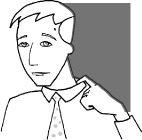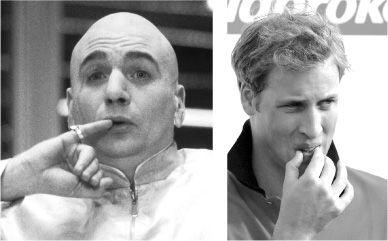The Definitive Book of Body Language (25 page)
Read The Definitive Book of Body Language Online
Authors: Barbara Pease,Allan Pease

Showing uncertainty
Desmond Morris was one of the first to discover that lies cause a tingling sensation in the delicate facial and neck tissues, and a rub or scratch was required to satisfy it. This not only accounts for why people who are uncertain will scratch their neck, it presents a good explanation as to why some people use the Collar Pull when they lie and suspect they have been caught out. Increased blood pressure from the deceit causes sweat to form on the neck when the deceiver feels that you suspect he's not telling the truth.

Getting hot under the collar
It also occurs when a person is feeling angry or frustrated and needs to pull the collar away from his neck in an attempt to let the cool air circulate. When you see someone use this gesture, ask, “Could you repeat that, please?” or “Could you clarify that point, please?” This can cause the would-be deceiver to give the game away.
This is an unconscious attempt by the person to revert to the security of the child sucking on his mother's breast and occurs when a person feels under pressure. A young child substitutes his thumb or a blanket for his mother's breast and, as an adult, he puts his fingers to his mouth, sucks on cigarettes, pipes, pens, and glasses, and chews gum.

Reassurance is needed here
Most Hand-to-Mouth gestures can be connected to lying or deception, but the Fingers-in-Mouth gesture is an outward indication of an inner need for reassurance, so giving the person guarantees and assurances is a positive move.
A good speaker is said to be one who “instinctively” knows when his audience is interested in what he's saying and can also tell when his listeners have had enough. A good salesperson senses when he is hitting his client's “hot buttons” and finding out where the buyer's interest lies. Every presenter knows the empty feeling that results when he or she is giving a presentation to someone who says very little and just sits there watching.
Fortunately, there are a number of Hand-to-Cheek and Hand-to-Chin gestures that can be used as a thermometer to test how hot or cold the other person's attitude is, and to tell the speaker how well he is doing.
When the listener begins to use his hand to support his head, it is a signal that boredom has set in and his supporting hand is an attempt to hold his head up to stop himself from falling asleep. The degree of the listener's boredom is related to the extent to which his arm and hand are supporting his head. It usually begins with the chin being supported by the thumb and then by the fist as interest wanes. Extreme lack of interest is shown when the head is fully supported by the hand (see illustration), and the ultimate boredom signal occurs when the head is fully supported by the hands and snoring sounds are evident.

The hand supporting the head to stop from falling asleep
Drumming the fingers on the table and continual tapping of the feet on the floor are often misinterpreted by professional speakers as boredom signals, but in fact signal impatience. If you are addressing a group of people and see these signals, a strategic move must be made to get the finger-drummer or foot-tapper involved in the conversation to avoid his negative effect on the other listeners. Any audience that displays boredom and impatience signals together is telling the speaker that it is time for him to end.
“Do you talk in your sleep?”he asked the speaker.
“No,”came the reply.“Then please don't talk in mine.”
The speed of the finger or foot tap is related to the extent of the person's impatience—the faster the taps, the more impatient the listener is becoming.
Evaluation is shown by a closed hand resting on the chin or cheek, often with the index finger pointing upward. When the person begins to lose interest but still wants to appear interested for courtesy's sake, the position will alter so that the heel of the palm supports the head as boredom sets in.

Interested evaluation— the head supports itself and the hand rests on the cheek
Middle managers often use this gesture to feign interest to the company president who is giving a dull, boring speech. Unfortunately for them, however, as soon as the hand begins to support the head in any way, it gives the game away and the president is likely to feel that some of the managers are being insincere or using false flattery.

Having negative thoughts
Genuine interest is shown when the hand lightly rests on the cheek and is not used as a head support. When the index finger points vertically up the cheek and the thumb supports the chin, the listener is having negative or critical thoughts about the speaker or his subject. Sometimes the index finger may rub or pull at the eye as the negative thoughts continue.

He's heard enough or is not impressed
This gesture is often mistaken as a signal of interest, but the supporting thumb under the chin tells the truth about the critical attitude. Holding a gesture cluster affects a person's attitude, so the longer a person holds it, the longer their critical attitude will remain. This gesture cluster is a signal that immediate action is required by the speaker, either by involving the listener in what he is saying or by ending the encounter. A simple move, such as handing something to the listener to alter his pose, can cause a change in attitude.

Rodin's “The Thinker” showed a thoughtful, evaluative attitude, but the body posture and hand supporting the head also reveal a dejected person
We interviewed a man who had arrived from abroad to apply for a position with our company. Throughout the interview he kept his arms and legs crossed, used critical evaluation clusters, had very little palm use, and he looked away frequently. Something was obviously worrying him, but in the early stages of the interview we didn't have sufficient information for an accurate assessment of his negative gestures. We asked questions about his previous employers in his native country. His answers included a series of eye-rubbing and nose-touching gestures and he continued to look away. We eventually decided not to hire him, based on what we had seen as opposed to what he had said. We were curious about his deceit gestures and when we checked with his overseas references, we discovered that he had given false information about his past. He assumed that a potential employer in another country probably wouldn't bother to check overseas references and, had we not been aware of the body-language cues and signals, we could have made the mistake of hiring him.
The next time you have the opportunity to present an idea to a group of people, watch them carefully as you give your idea and you may notice that most will bring one hand up to their face and use an evaluation gesture. When you come to the end of your presentation and ask the group to give opinions or suggestions about your ideas, the evaluation gestures will usually stop and a Chin Stroking gesture begins. This Chin Stroke is the signal that the listener is going through the decision-making process.